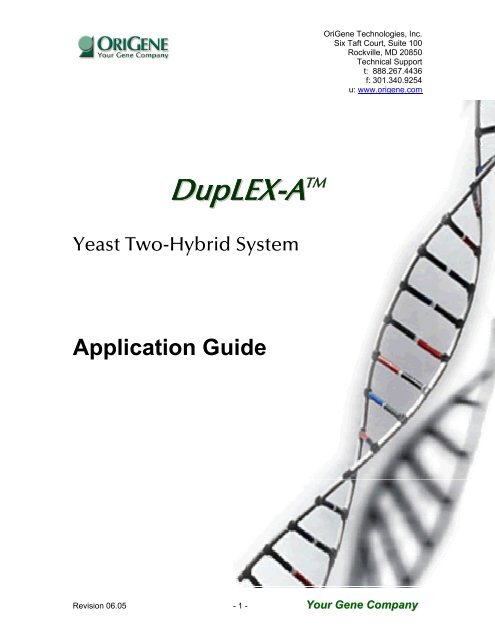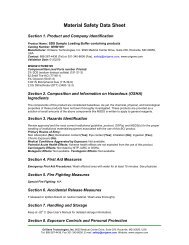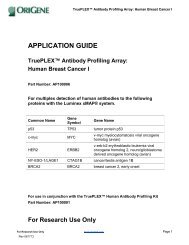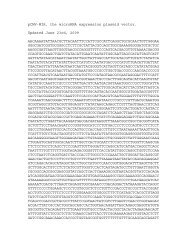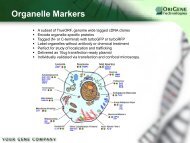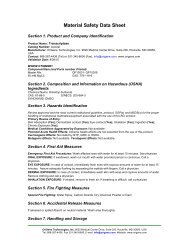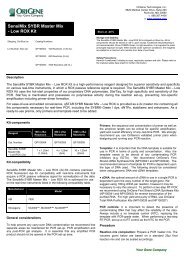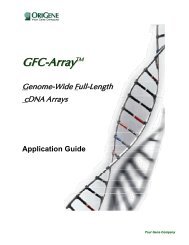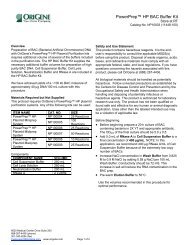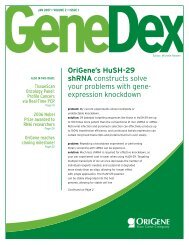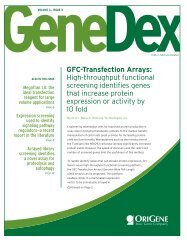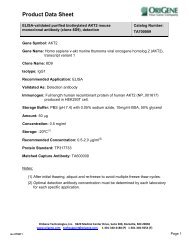DupLEX-A Yeast Two-Hybrid Kit - OriGene
DupLEX-A Yeast Two-Hybrid Kit - OriGene
DupLEX-A Yeast Two-Hybrid Kit - OriGene
Create successful ePaper yourself
Turn your PDF publications into a flip-book with our unique Google optimized e-Paper software.
<strong>OriGene</strong> Technologies, Inc.<br />
Six Taft Court, Suite 100<br />
Rockville, MD 20850<br />
Technical Support<br />
t: 888.267.4436<br />
f: 301.340.9254<br />
u: www.origene.com<br />
<strong>DupLEX</strong>-A TM<br />
<strong>Yeast</strong> <strong>Two</strong>-<strong>Hybrid</strong> System<br />
Application Guide<br />
Revision 06.05 - 1 - Your Gene Company
<strong>DupLEX</strong>-A TM <strong>Yeast</strong> <strong>Two</strong>-<strong>Hybrid</strong> System – Application Guide<br />
Table of Contents<br />
Application Guide..............................................................................................................................1<br />
Table of Contents ..............................................................................................................................2<br />
Package Contents and Storage Conditions....................................................................................3<br />
<strong>Yeast</strong> strains....................................................................................................................................3<br />
Reporter gene (LacZ) plasmids (2 µg each) ...................................................................................3<br />
Bait plasmids ...................................................................................................................................3<br />
Target plasmid.................................................................................................................................3<br />
Control plasmids (2 µg each) ..........................................................................................................3<br />
Primers (10 µg each).......................................................................................................................4<br />
Other items included in the kit:........................................................................................................4<br />
Other required Reagents.................................................................................................................4<br />
<strong>Yeast</strong> growth media................................................................................................................................... 4<br />
Bacterial growth media.............................................................................................................................. 5<br />
For yeast transformations.......................................................................................................................... 5<br />
For bacterial transformations..................................................................................................................... 5<br />
For rescuing plasmids from yeast.............................................................................................................. 5<br />
Filter assay for β-galactosidase and yeast X-gal plates............................................................................. 5<br />
Related Products.............................................................................................................................6<br />
Introduction........................................................................................................................................6<br />
Overview .........................................................................................................................................6<br />
Flow-Chart for <strong>DupLEX</strong>-A <strong>Yeast</strong> <strong>Two</strong>-<strong>Hybrid</strong> Screen .....................................................................7<br />
Methods ..............................................................................................................................................7<br />
Constructing the Bait.......................................................................................................................7<br />
Testing the autoactivation potential of the bait (LacZ) ....................................................................7<br />
Testing the autoactivation potential of the bait (LEU2) ...................................................................9<br />
Testing the bait’s ability to enter the nucleus and bind LexA operators..........................................9<br />
Performing a large-scale library transformation ............................................................................10<br />
Screening for potential positive transformants..............................................................................11<br />
Recovering plasmids from yeast ...................................................................................................12<br />
Obtaining potential positive target plasmids in bacteria................................................................12<br />
Determining the specificity of the interaction using mating tests ..................................................13<br />
Trouble-Shooting Guide .................................................................................................................14<br />
Frequently asked questions ...........................................................................................................14<br />
Appendix ..........................................................................................................................................15<br />
<strong>Yeast</strong> Growth Media......................................................................................................................15<br />
Bacterial Growth Media.................................................................................................................16<br />
Solutions........................................................................................................................................17<br />
Library Information ........................................................................................................................17<br />
Working with <strong>Yeast</strong>........................................................................................................................18<br />
Polylinker Sequences....................................................................................................................18<br />
pEG202 ................................................................................................................................................... 19<br />
pNLexA.................................................................................................................................................... 20<br />
pEG202-NLS ........................................................................................................................................... 21<br />
pJG4-5..................................................................................................................................................... 22<br />
pJK101 .................................................................................................................................................... 23<br />
LacZ ........................................................................................................................................................ 24<br />
pGilda...................................................................................................................................................... 25<br />
Limited License Agreement...........................................................................................................25<br />
Revision 06.05 - 2 - Your Gene Company
Package Contents and Storage Conditions<br />
NOTE. All of the components listed below are required. Read the manual carefully to<br />
determine which components are best suited for a library screen.<br />
<strong>Yeast</strong> strains<br />
o EGY48 MATα trp1 his3 ura3 leu2::6 LexAop-LEU2 (high sensitivity)<br />
o EGY194 MATa trp1 his3 ura3 leu2::4 LexAop-LEU2 (medium sensitivity)<br />
o EGY188 MATa trp1 his3 ura3 leu2::2 LexAop-LEU2 (low sensitivity)<br />
o EGY40 MATα trp1 his3 ura3 leu2::0 LexAop-LEU2 (negative control)<br />
o RFY206 MATa trp1Δ::hisG his3Δ200 ura3-52 lys2Δ201 leu2-3 (mating<br />
strain)<br />
Streak on YPD plates and grow at 30°C for 2–3 days; start cultures from single<br />
colonies.<br />
Reporter gene (LacZ) plasmids (2 µg each)<br />
o pSH18-34 URA3, 2 µ, Amp r , 8 ops.-LacZ (high sensitivity)<br />
o pJK103 URA3, 2 µ, Amp r , 2 ops.-LacZ (medium sensitivity)<br />
o pRB1840 URA3, 2 µ, Amp r , 1 op.-LacZ (low sensitivity)<br />
o pJK101 URA3, 2 µ, Amp r , GAL1-2 ops.-LacZ (used in repression assay)<br />
Bait plasmids<br />
o pEG202: HIS3, 2 µ, Amp r , (constitutive ADH promoter expresses LexA and<br />
is followed by a polylinker for making the bait fusion protein);10 µg<br />
o pEG202-NLS: HIS3, 2 µ, Amp r , (similar to pEG202 but with SV40 nuclear<br />
localization sequence between LexA and polylinker); 2 µg<br />
o pNLexA: HIS3, 2 µ, Amp r , (similar to pEG202 except that the LexA<br />
sequence is 3’ rather than 5’ of the polylinker); 2 µg<br />
Target plasmid<br />
o pJG4-5: TRP1, 2 µ, Amp r , (inducible GAL1 promoter expresses B42-HA<br />
tag and is followed by a polylinker for making target fusion protein<br />
expression libraries from cDNA); 10 µg<br />
Control plasmids (2 µg each)<br />
o pRHFM1: HIS3, 2 µ, Amp r , (ADH promoter expresses LexA-Bicoid<br />
homeodomain fusion; used as a positive control in the repression<br />
assay and a negative control in the <strong>DupLEX</strong>-A screen)<br />
o pSH17-4: HIS3, 2 µ, Amp r , (ADH promoter expresses LexA-GAL4 activation<br />
domain; used as a positive control in the <strong>DupLEX</strong>-A screen)<br />
o pEG202-Max: Expresses LexA-Max fusion constitutively; used as a negative<br />
control when testing isolated target proteins or as a positive<br />
control in the repression assay<br />
Revision 06.05 - 3 - Your Gene Company
o pBait: Constitutively expresses a LexA-bait fusion protein that interacts<br />
with the fusion protein from pTarget (see below); can also be used<br />
as a negative control when testing isolated target proteins or as a<br />
positive control in the repression assay)<br />
o pTarget: Expresses (galactose-dependently) a B42-target fusion protein<br />
that interacts with the fusion protein from pBait (see above)<br />
Primers (10 µg each)<br />
NOTE. The concentration of each oligonucleotide is approximately 80 µM.<br />
o<br />
o<br />
o<br />
5’ bait fusion primer: 5’-CGT CAG CAG AGC TTC ACC-3’ (used to determine<br />
the sequence of the junction between LexA and the bait)<br />
5’ target fusion primer: 5’-CTG AGT GGA GAT GCC TCC-3’ (used to<br />
determine the reading frame and identity of positive clones; also,<br />
can be used with 3’ target primer to amplify clone by PCR)<br />
3’ target fusion primer: 5’-GCC GAC AAC CTT GAT TG-3’ (used to determine<br />
the identity of positive clones; also, can be used with 5’ target<br />
primer to amplify clone by PCR)<br />
Other items included in the kit:<br />
o pJG4-6: TRP1, 2 µ, Amp r , (similar to pJG4-5 but without B42 activation<br />
domain; used to express an isolated target protein in yeast); 10 µg<br />
o Sonicated salmon sperm DNA, 5 mg/mL (prepared specially for yeast<br />
transformation); 10 mg total [CARRIER DNA]<br />
o Escherichia coli strain KC8 (pyrF, leuB600, trpC, hisB463)<br />
o<br />
<strong>DupLEX</strong>-A Applications Guide<br />
Other required Reagents<br />
NOTE. The specific materials listed below are ones tested by <strong>OriGene</strong> in the <strong>DupLEX</strong>-A<br />
system. Similar items from other sources may be interchangeable.<br />
<strong>Yeast</strong> growth media<br />
Vendor Catalog #<br />
• peptone BIO 101 4018-512<br />
• agar BIO 101 4019-512<br />
• yeast extract BIO 101 4018-012<br />
• yeast nitrogen base BIO 101 4027-012<br />
w/o amino acids<br />
• raffinose Sigma R-0250<br />
• dextrose (glucose) Fisher D16-1<br />
• galactose (glucose-free) Sigma G-0750<br />
• dropout mix BIO101 4540-022<br />
(–his –ura –trp –leu)<br />
• uracil Sigma U-0750<br />
• leucine Sigma L-5652<br />
• tryptophan Sigma T-0254<br />
Revision 06.05 - 4 - Your Gene Company
• histidine Fisher BP382-100<br />
Bacterial growth media<br />
• LB broth Difco 0402-07-0<br />
• magnesium sulfate Fisher BP213-1<br />
• potassium phosphate Mallinckrodt 7100<br />
(monobasic)<br />
• potassium phosphate Fisher BP363-500<br />
(dibasic)<br />
• sodium citrate Fisher BP327-1<br />
• thiamine hydrochloride Fisher BP892-100<br />
• ammonium sulfate Fisher BP212R-1<br />
• kanamycin Fisher BP906-5<br />
• ampicillin Boehringer Mann. 835 2697<br />
For yeast transformations<br />
• lithium acetate Fisher AC19984-2500<br />
• polyethylene glycol-3350 Sigma P146-3<br />
• dimethyl sulfoxide Fisher D136-1<br />
• hydrochloric acid Fisher A144-500<br />
• tris base Fisher BP152-5<br />
• EDTA Fisher 02793-500<br />
For bacterial transformations<br />
• glycerol Sigma G-5516<br />
• ElectroMax DH10B Gibco/BRL 18290-015<br />
(competent cells)<br />
• SOC medium Gibco/BRL 15544-018<br />
• electroporator Gibco/BRL 11613-015<br />
For rescuing plasmids from yeast<br />
• glass beads, acid-washed Sigma G8772<br />
• Triton-X-100 Fisher BP151-100<br />
• sodium acetate Fisher S209-500<br />
• ethanol Aldrich 18,738-0<br />
• phenol Fisher BP1750I-400<br />
• chloroform Fisher BP1145-1<br />
• isoamyl alcohol Fisher BP1150-500<br />
• SDS Sigma L-4509<br />
Filter assay for β-galactosidase and yeast X-gal plates<br />
• sodium phosphate Fisher BP329-500<br />
(monobasic)<br />
• sodium phosphate Mallinckrodt 7914<br />
(dibasic)<br />
• potassium chloride Mallinckrodt 6858<br />
• β-mercaptoethanol Fisher 03446I-100<br />
• nylon membrane filters MSI N04SP09025<br />
Revision 06.05 - 5 - Your Gene Company
• X-gal (5-bromo-4-chloro-3- Gold BioTech. X4281C<br />
indoyl-β-D-galactopyranoside)<br />
• N,N-dimethyl formamide Fisher BP1160-5008<br />
Related Products<br />
TrueClone cDNA clones http://www.origene.com/cdna/<br />
HuSH TM shRNA Plasmids http://www.origene.com/rna/<br />
Validated Antibodies http://www.origene.com/antibody/<br />
Functional Proteins http://www.origene.com/protein/<br />
MultipleChoice TM Northern Blots http://www.origene.com/geneexpression/rna_blots/<br />
Introduction<br />
Overview<br />
The <strong>DupLEX</strong>-A system is a LexA-based version of the yeast two-hybrid system<br />
originally developed by Fields and Song (1). The yeast two-hybrid system has proven to<br />
be a powerful tool for identifying proteins from an expression library which can interact with<br />
one’s protein of interest. The <strong>DupLEX</strong>-A system was developed as a more versatile and<br />
more accurate version of the yeast two-hybrid system (2).<br />
The two-hybrid system of Fields and Song exploits the fact that a yeast transcriptional<br />
activator protein, GAL4, has a separable DNA binding domain and activation domain;<br />
neither domain can activate transcription on its own (3). Transcriptional activation is<br />
detected only when the binding domain is bound to its DNA recognition sequence and is<br />
also tethered to the activation domain. The two-hybrid system involves fusing the GAL4<br />
binding domain with a protein “X” and the GAL4 activation domain with a protein “Y”. If “X”<br />
and “Y” interact, then a functional GAL4 is restored and transcriptional activation can be<br />
detected. If binding sites for GAL4 are placed upstream of a reporter gene (such as<br />
LacZ), transcriptional activation can be monitored easily.<br />
The <strong>DupLEX</strong>-A system utilizes the same basic idea except that the DNA binding protein<br />
is the Escherichia coli LexA protein while the activation protein is the acid blob domain<br />
B42. Neither LexA protein bound upstream of a reporter gene nor B42 alone can activate<br />
transcription of the reporter, but if brought together via fusions with two interacting<br />
proteins; reporter gene expression can be detected (2).<br />
Advantages of the <strong>DupLEX</strong>-A system over other yeast two-hybrid systems include:<br />
• Reduction in the number of false positives obtained since prokaryotic (LexA and<br />
B42) rather than eukaryotic (GAL4) proteins are used<br />
• Ability to screen potentially toxic target proteins since their expression is galactoseinducible<br />
• Ability to demonstrate a potential positive’s interaction with bait is dependent upon<br />
expression of the potential positive<br />
• Ease of doing a co-immunoprecipitation assay of bait and potential positive since<br />
antibodies to HA tag (fused downstream of B42) are available (if antibody to the<br />
bait protein is also available)<br />
Revision 06.05 - 6 - Your Gene Company
• Reporters with varying sensitivities are available so that baits which activate<br />
transcription on their own can potentially still be assayed simply by using a less<br />
sensitive reporter<br />
• Ease of determining whether or not a particular bait protein will enter the yeast<br />
nucleus and bind LexA operators<br />
1. Fields, S. and Song, O. (1989). Nature 340, 245-247.<br />
2. Gyuris, J., Golemis, E. A., Chertkov, H., and Brent, R. (1993). Cell 75, 791-803.<br />
3. Chien, C. T. et al. (1991). Proc. Natl. Acad. Sci. USA 88, 9578-9582.<br />
Flow-Chart for <strong>DupLEX</strong>-A <strong>Yeast</strong> <strong>Two</strong>-<strong>Hybrid</strong> Screen<br />
A. Subclone gene for bait protein into pEG202; verify correct reading frame; go to<br />
step B.<br />
B. Transform into all four yeast strains to test for autoactivation:<br />
o If no autoactivation, then go to step C.<br />
o<br />
If it autoactivates, then subclone only a portion of the bait gene into<br />
pEG202 and retest. If the truncated bait does not autoactivate, then go to<br />
step C.<br />
C. Transform into appropriate strain along with pJK101 to test whether or not the bait<br />
fusion can enter the nucleus and bind LexA operators or not.<br />
o If binding is detected, go to step D.<br />
o<br />
If no binding is detected, then subclone into pEG202-NLS and retest. If<br />
binding is detected on the retest, then proceed to step D.<br />
D. Transform into yeast strain, with reporter. A Western Blot to check for bait protein<br />
expression at this point is optional. Go to step E.<br />
E. Transform with the library (large-scale). Go to step F.<br />
F. Scrape colonies off plates and freeze in aliquots. Go to step G.<br />
G. Titer the cells and replate, selecting for interactors (LEU2 + ). Go to step H.<br />
H. Grid positives to small plates, perform lacZ filter assay. Go to step I.<br />
I. Rescue target plasmid from positives, transform back into strain along with<br />
reporter, and mate with opposite mating type strain containing different control<br />
baits. Go to step J.<br />
J. Sequence positives, search sequence databases for homology.<br />
Methods<br />
Constructing the Bait<br />
Using standard recombinant DNA techniques, subclone the bait protein gene in the correct<br />
orientation into the polylinker of pEG202 (see Page 19). Design the bait protein gene subcloning<br />
such that it fuses in-frame with LexA. It is strongly recommend that the sequence of the LexA-bait<br />
junction is verified to ensure that a LexA-cDNA fusion protein should be made.<br />
NOTE. It is highly recommended that the bait fusion protein be tested in the assays below before<br />
performing a full-scale library screen.<br />
Testing the autoactivation potential of the bait (LacZ)<br />
Some bait proteins can activate reporter genes on their own, making a two-hybrid system library<br />
screen not possible. However, the <strong>DupLEX</strong>-A system offers some alternatives if this occurs. To<br />
test for autoactivation by the bait fusion, transform yeast strain EGY48 with the following<br />
combinations of plasmids:<br />
Revision 06.05 - 7 - Your Gene Company
1. pEG202-Bait + pSH18-34 (test)<br />
2. pSH17-4 + pSH18-34 (strong activation)<br />
3. pRHFM1 + pSH18-34 (no activation)<br />
(a) Small-scale <strong>Yeast</strong> Transformation Protocol<br />
• Grow a 5 mL culture of EGY48 in YPD at 30°C with shaking (overnight). Inoculate by picking a<br />
colony off of a streaked plate of EGY48.<br />
• Measure the OD 600 of a 1:10 dilution of the overnight culture. Calculate the OD 600 of the 5 mL<br />
culture and use that to inoculate a 60 mL YPD culture to give an OD 600 = 0.1. Grow at 30°C with<br />
shaking.<br />
• When the OD 600 = 0.5–0.7 (approximately 4–6 hours after inoculation), pellet the cells by spinning<br />
the culture at 1500 × g for 5 min. Resuspend in 20 mL of sterile distilled water, spin again, and<br />
resuspend the pellet in 0.3 mL of 1× TE/LiOAc. Pipette 100 µL into each of three sterile 1.5-mL<br />
microcentrifuge tubes.<br />
• Boil the carrier DNA for 5 min and quickly chill on ice. This is necessary for obtaining a maximum<br />
efficiency of transformation; however, it should only be done every third or fourth time the carrier<br />
DNA is used.<br />
• Add 100 ng of each plasmid DNA and 50 µg of denatured carrier DNA to each tube and mix.<br />
• Add 0.3 mL of 1× TE/LiOAc/PEG, mix by inversion, and place the tubes at 30°C (with or without<br />
shaking) for 30 min.<br />
• Add 70 µL of DMSO (dimethyl sulfoxide) to each sample, mix by inversion, and place at 42–45°C<br />
(without shaking) for 15 min.<br />
• Spin at 10,000 rpm in a microcentrifuge for 10 sec, pour off the supernatant, and resuspend each<br />
pellet in 0.5 mL of sterile distilled water.<br />
• Spread 50–100 µL of each sample onto separate YNB (glu) –his –ura plates. Incubate at 30°C<br />
for 2–3 days.<br />
• Streak four colonies from each plate onto another YNB (glu) –his –ura plate. Inoculate at 30°C for<br />
1–2 days. Perform a LacZ filter assay or replica to YNB(gal)-his-ura + X-gal plates and grow at<br />
30°C overnight.<br />
(b) Filter Assay<br />
Cut a piece of Whatman 3M paper such that it just fits into a 100-mm petri dish. Place the paper in<br />
an empty dish and add 2 mL of 1 mg/mL X-gal (add 20 µL of X-gal in N,N-dimethyl formamide to 2<br />
mL of Z buffer), making sure the paper is completely wet. Place a similarly-cut nitrocellulose filter<br />
on the surface of the plate containing the re-streaked yeast, then gently remove it off of the plate<br />
and place the filter in a –70°C freezer for 5-10 min. Remove the filter, let thaw, and re-freeze it at –<br />
70°C. Remove the filter and place it yeast side up on the pre-wetted Whatman filter paper.<br />
Incubate at 30°C for 2 hr.<br />
The colonies containing pSH17-4 should turn blue, the colonies containing pRFHM1 should not turn<br />
blue, and the colonies containing the pEG202-Bait plasmid may or may not turn blue. If pEG202-<br />
Bait-containing colonies do not turn blue, then the bait does not autoactivate reporter gene<br />
expression and can be used for screening in the yeast strain EGY48. If the same colonies turn blue<br />
Revision 06.05 - 8 - Your Gene Company
in the above assay, then the test should be repeated using either pJK103 or pRB1840 in place of<br />
pSH18-34 as the reporter plasmid. If the bait fails to autoactivate in the presence of either reporter<br />
plasmid, then either reporter can be used in a two-hybrid screen. If the bait continues to<br />
autoactivates with these reporter plasmids it cannot be used in a screen. To circumvent this<br />
problem, try subcloning only portions of the gene encoding the bait protein into pEG202 and repeat<br />
the autoactivation experiments.<br />
Testing the autoactivation potential of the bait (LEU2)<br />
Since LEU2 is the reporter used in the initial screen, it is important not to have a high background of<br />
colonies arising due to activation of the LEU2 gene by the bait alone. Also, for some baits, the<br />
LEU2 reporter in EGY48 is more sensitive than the lacZ reporter on pSH18-34. Therefore, the<br />
ability of the bait to autoactivate the LEU2 reporter should be tested before performing a large<br />
screen.<br />
• Using a sterile wooden applicator stick, transfer a colony of EGY48 containing the bait plasmid<br />
into 0.5 mL of sterile distilled water. Vortex. Dilute 100 µL into 1 mL of sterile distilled water.<br />
Vortex. This is Dilution 1. Perform three more serial 1:10 dilutions (Dilutions 2–4) such that if<br />
Dilution 1 is considered “undiluted”, Dilution 2 = 1:10 diluted, Dilution 3 = 1:100 diluted, and<br />
Dilution 4 = 1:1000 diluted.<br />
• Plate 100 µL of each of Dilutions 1–4 onto YNB (gal) –his plates and onto YNB (gal) –his –leu<br />
plates. Incubate at 30°C for 1–2 days. Colonies should be seen on the –his plates but not on the<br />
–his –leu plates. (Note: galactose plates are used in this experiment since that is the carbon<br />
source that will be used during the LEU2 selection step of the large-scale screen.) If many<br />
colonies are obtained on the –his –leu plates, then the bait is autoactivating and the assays<br />
should be re-done using the bait in strains EGY194 and EGY188. Strain EGY40 is included as a<br />
negative control. In addition, three different sensitivity LacZ reporter plasmids are included:<br />
pSH18-34 > pJK103 > pRB1840 (most sensitive > least sensitive).<br />
Once convinced that the bait fusion can enter the nucleus and bind to LexA operators without<br />
autoactivating either of the two reporter genes, then a large-scale library screen can be performed.<br />
Note that for an unknown reason, some baits can autoactivate the reporter genes in a large-scale<br />
screen even when they did not autoactivate in small-scale tests. Therefore, it might be<br />
advantageous to perform a “medium-scale” screen, perhaps one-fifth the size of a large scale<br />
screen, first.<br />
Testing the bait’s ability to enter the nucleus and bind LexA operators<br />
The plasmid pJK101 contains a LacZ reporter gene whose expression is driven by the yeast GAL1<br />
promoter. However, two LexA operators have been placed between the GAL1 promoter and the<br />
LacZ gene; LexA fusion proteins will bind to these operators and decrease the level of GAL1-<br />
driven LacZ expression.<br />
(c) Repression Assay<br />
• Perform the following transformations into EGY48 (see protocol under section 4 (ii)):<br />
1. pEG202-Bait + pJK101 (test)<br />
2. pEG202-Max + pJK101 (repression)<br />
3. pJK101 alone (no repression)<br />
NOTE. Plate transformations 1 and 2 above onto YNB (glu) –his –ura and transformation 3 onto<br />
YNB (glu) –ura plates.<br />
Revision 06.05 - 9 - Your Gene Company
• Streak four colonies from each of plates 1 and 2 above onto YNB (gal) –his –ura + X-gal plates<br />
and four colonies from plate 3 onto YNB (gal) –ura + X-gal plates. After 12–24 hours at 30°C, it<br />
should be evident whether or not the bait fusion can bind to the LexA operators. If some level of<br />
repression is observed, then proceeding with the screen can be done. If no repression is seen,<br />
then the bait should be tested if it is even being synthesized (a Western blot can be performed if<br />
antibodies against the bait exist). If there is evidence that the protein is being made in yeast, then<br />
try re-cloning the bait into pEG202-NLS (formerly called pJK202; see Page 21). The vector<br />
pEG202-NLS contains a nuclear localization sequence fused to LexA just upstream of the<br />
polylinker sequence.<br />
Performing a large-scale library transformation<br />
• Grow a 20 mL overnight culture (at 30°C) of EGY48 (or EGY194 or EGY188) containing the LacZ<br />
reporter plasmid (pSH18-34, for example) and the bait plasmid. Grow in YNB (glu) –his –ura<br />
medium.<br />
• The next morning, dilute 100 µL of culture into 0.9 mL of water, mix well, and immediately<br />
measure the OD600 of the dilution. Multiply by 10 to get the OD600 of the undiluted culture.<br />
Inoculate 300 mL of YPD medium (in a sterile 2 L flask) with enough of the overnight culture to<br />
give an OD600 = 0.1. For example, if the dilution of the overnight culture had an OD600 = 0.5,<br />
then the 20 mL undiluted overnight culture would have an OD600 = 0.5 × 10 = 5. Since the 300<br />
mL culture should start at OD600 = 0.1, the amount of undiluted culture needed would be 0.1/5 ×<br />
300 mL = 6 mL. Therefore, add 6 mL of undiluted overnight culture to 300 mL of YPD. (Note:<br />
without agitation, yeast cells will settle to the bottom of a flask over time, therefore, always swirl<br />
the flask before removing any culture to ensure the culture is of uniform density.)<br />
• Shake the culture vigorously at 30°C until the OD600 = 0.5–0.7. This should take 4–5 hours.<br />
• Harvest the cells by spinning at 1,500 × g (3,000 rpm in a GSA rotor) for 5 min (room<br />
temperature). Pour off the supernatant.<br />
• Resuspend in 30 mL of sterile distilled water, transfer to a 50-mL sterile conical tube, and spin at<br />
1,500 × g (2,500 rpm in an HL-4 rotor) for 5 min (room temperature). Pour off the supernatant.<br />
• Resuspend the cell pellet in 1.5 mL of 1× TE/LiOAc. Aliquot 50 µL portions into 30 sterile 1.5-mL<br />
microcentrifuge tubes. (Note: a higher transformation efficiency is obtained when several small<br />
transformations are performed rather than one large transformation.)<br />
• Denature the carrier DNA by placing the tube in a boiling water bath for 5 min and then quickly<br />
placing the tube on ice (do this only if the carrier has not been denatured in the last two or three<br />
sets of transformations that have been done). Incubate on ice for five minutes.<br />
• Add 50 µg (10 µL) of carrier DNA and 1 µg of pJG4-5-based plasmid library DNA to each<br />
microcentrifuge tube. Do not use more than 1 µg of library DNA per tube since this can lead to<br />
the introduction of multiple plasmids into a single yeast cell and subsequently give confusing<br />
results in later analyses.<br />
• Add 300 µL of 1× TE/LiOAc/PEG to each tube and mix by inversion. Incubate (without agitation)<br />
at 30°C for 30 min.<br />
• Add 40 µL of DMSO to each tube, mix by inversion, and heat shock by incubating at 42–45°C for<br />
20 min.<br />
• Add 0.6 mL of sterile distilled water to each tube and mix by inversion. Dilute 10 µL of one<br />
sample into 990 µL of sterile distilled water, vortex, and plate 100 µL of the dilution onto a 100-<br />
Revision 06.05 - 10 - Your Gene Company
mm YNB (glu) –his –ura –trp plate. Plate all samples from each tube onto 30 separate 24 cm ×<br />
24 cm YNB (glu) –his –ura –trp plates (or 300 µL onto each of 100 150-mm YNB (glu) –his –trp –<br />
ura plates. Incubate all plates at 30°C for 2–3 days, until colonies appear.<br />
• Calculate the number of transformants obtained by counting the number of colonies on the 100-<br />
mm plate. For example, 100 colonies corresponds to an efficiency of 105/µg, therefore, the total<br />
number of transformants is 30 µg × 105/µg = 3 × 106 total transformants. Similarly, 50 colonies<br />
corresponds to an efficiency of 5 × 104/µg, or 1.5 × 106 total transformants. A saturating screen<br />
of a mammalian library requires at least 2 × 106 transformants.<br />
• Harvest the transformants as follows:<br />
• Soak a microscope slide in ethanol, then let air-dry.<br />
• Pipet 10 mL of sterile distilled water onto each 24 cm × 24 cm colony plate, scrape off the<br />
colonies with the long edge of the microscope slide (taking care to use good sterile technique),<br />
and pipet the slurry into a sterile disposable centrifuge tube.<br />
• Centrifuge for 5 min at 1,500 × g (2,500 rpm in an HL-4 rotor) at room temperature. Pour off the<br />
supernatant, resuspend the pellet in a total of about 75 mL of sterile distilled water, spin again as<br />
above, and pour off the supernatant. Resuspend the pellet in an equal volume of sterile distilled<br />
water. Estimate the total volume, add half a volume of sterile 50% (v/v) glycerol, mix, and freeze<br />
1 mL aliquots at –70°C. Frozen stocks will remain good for at least 1 year when stored at –70°C.<br />
Screening for potential positive transformants<br />
(a) Titer the number of viable cells<br />
• Thaw an aliquot of the frozen yeast transformants and dilute 1:10 with YNB (gal) –his –ura –trp<br />
medium. Shake at 30°C for 4 hr to induce the GAL1 promoter.<br />
• Perform serial dilutions of the transformants in YNB (gal) –his –ura –trp and plate 100 µL of each<br />
dilution onto separate YNB (gal) –his –ura –trp plates. Incubate at 30°C for 2–3 days, until<br />
colonies are visible.<br />
• Calculate the number of colony-forming units (cfu) per frozen aliquot of yeast transformants.<br />
(b) Screen for Leu + colonies<br />
• To fully screen all the transformants, about 5–7 times the number of original transformants<br />
obtained should be screened. (Therefore, if 3 × 106 transformants were originally obtained ,<br />
then about 2 × 107 cfu should be plated. Thaw enough of the frozen transformants equal to that<br />
number of cfu.<br />
• The number of cfu per 1 mL frozen aliquot can be used to estimate an OD600 of the aliquot since<br />
1 OD600 = 2 × 107 yeast cells. That is, the number of cfu/2 × 107 = OD600 of the aliquot. Dilute<br />
the appropriate amount of frozen transformants with YNB (gal) –his –ura –trp –leu medium, down<br />
to approximately 1 × 107 cells/mL (OD600 = 0.5). Shake at 30°C for 4 hr.<br />
• Plate 100 µL aliquots onto 100-mm YNB (gal) –his –ura –trp –leu plates. This corresponds to a<br />
screen of about 1 × 106 cfu per plate (do not exceed this number). Incubate at 30°C for 2 days,<br />
until colonies appear.<br />
Revision 06.05 - 11 - Your Gene Company
• Pick colonies onto a YNB (gal) –his –ura –trp –leu master plate and incubate at 30°C for a few<br />
days, until new colonies appear. Refer back to the plates from the step above and create another<br />
master plate for colonies which arise three days after plating and another master plate for<br />
colonies which arise four days after plating. Colonies from the first two master plates should<br />
definitely be characterized further. Colonies that do not appear until about a week after plating<br />
are likely to be artifactual and should not be characterized further, unless they are the only<br />
colonies obtained.<br />
(c) Test galactose growth dependence and LacZ expression of potential positive transformants<br />
• Since the expression of the target protein is dependent on galactose, any colonies which can<br />
activate LEU2 and grow on –leu medium in the presence of glucose are false positives and<br />
should not be further characterized. Colonies that can grow on -leu medium containing galactose<br />
but that cannot grow on -leu medium containing glucose are potentially true positives and should<br />
be tested for LacZ expression. Re-streak colonies from the master plates onto the following<br />
types of plates:<br />
YNB (glu) –his –ura –trp –leu<br />
YNB (gal) -his –ura –trp –leu<br />
YNB (glu) -his –ura –trp + X-gal<br />
YNB (gal) -his –ura –trp + X-gal<br />
• Incubate at 30°C for 1–2 days, until growth occurs. Potential positive transformants will grow on<br />
the –leu (gal) plate but not the –leu (glu) plate, and will turn blue on the X-gal (gal) plate but not<br />
on the X-gal (glu) plate.<br />
• If the number of potential positives is small (50 potential positives are obtained, the first 50 that arise should be<br />
characterized and the rest frozen at –70°C in 20% glycerol.<br />
Recovering plasmids from yeast<br />
• To isolate DNA from the potential positives, grow each one in 2 mL of YNB(glu)-trp medium (or<br />
any other -trp medium you have available) at 30°C overnight.<br />
• Spin down 1.5 mL of each in microcentrifuge tubes for 10 sec at maximum speed. Pour off the<br />
supernatant, vortex to resuspend the pellet in the residual liquid, and add 200 µL of plasmid<br />
rescue solution.<br />
• Add 100 µL of phenol (tris-saturated, pH 8.0) and 100 µL of 24:1 chloroform: isoamyl alcohol.<br />
Add about 0.3 g of acid-washed glass beads and vortex vigorously for 2 min.<br />
• Spin at 14,000 rpm in a microcentrifuge for 5 min at room temperature. Carefully remove 200 µL<br />
from the top (aqueous) layer and transfer it to a clean tube. Add 20 µL of 3 M NaOAc, vortex,<br />
and add 440 µL of 95% ethanol. Vortex, spin for 20 min at 14,000 rpm in a microcentrifuge, pipet<br />
off and discard the supernatant, wash with 70% (v/v) ethanol, carefully pipet off and discard the<br />
supernatant, vacuum dry the pellet, and resuspend the pellet in 5 µL of sterile distilled water. Use<br />
1 µL to transform E. coli KC8 cells (see below).<br />
Obtaining potential positive target plasmids in bacteria<br />
The pellet recovered from the yeast cells in the above procedure consists mostly of yeast RNA and<br />
genomic DNA. Very little of it is library plasmid DNA. Also, the trp – E. coli strain used (KC8) is not<br />
very amenable to transformation. Therefore, electroporation of KC8 cells is recommended in order<br />
to recover the library plasmid.<br />
Revision 06.05 - 12 - Your Gene Company
Preparation of electrocompetent KC8 cells:<br />
• Streak KC8 onto a LBK plate and grow at 37°C overnight.<br />
• Pick a single colony and inoculate into 5 mL of LBK medium. Grow at 37°C overnight (with<br />
shaking).<br />
• Use all 5 mL to inoculate a 500 mL culture in LBK medium. Grow with shaking at 37°C until the<br />
OD 600 = 0.5.<br />
• Chill the cells on ice for 30 min. Spin at 5,000 rpm for 10 min at 4°C.<br />
• Pour off the supernatant and resuspend the pellet in 300 mL of ice-cold 10% glycerol. Spin again<br />
as above, pour off the supernatant, and resuspend the pellet in 150 mL of ice-cold 10% glycerol.<br />
• Spin again as above, pour off the supernatant, resuspend the pellet in 10 mL of ice-cold 10%<br />
glycerol, spin again as above, carefully pipette off and discard the supernatant, and resuspend<br />
the pellet in 2 mL of ice-cold 10% glycerol.<br />
• Aliquot into 75 µL portions and store at –70°C.<br />
• Electroporate 1 µL of the recovered yeast plasmid DNA into 75 µL of competent KC8 cells<br />
following the instructions of the particular electroporator being used. Plate onto LBA plates and<br />
grow at 37°C overnight. Colonies arising at this stage contain either the bait, target, or LacZ<br />
reporter plasmid.<br />
• To select only those colonies which contain the target plasmid, re-streak (or replica) the colonies<br />
from the LBA plate to a minimal (-trp) plate. Grow at 37°C overnight.<br />
• Prepare plasmid DNA from at least two colonies from each plate since more than one target<br />
plasmid can be present in a particular yeast cell. Digest the DNA with EcoRI and XhoI to release<br />
the insert and separate the sample by agarose gel electrophoresis to determine the insert size.<br />
Determining the specificity of the interaction using mating tests<br />
To determine whether the potential positives are specific for the particular bait used, test the<br />
positive clones against other baits with which it should not interact. This is most easily done by<br />
transforming the recovered library plasmid back into the yeast strain that was used in the screening<br />
(EGY48, for example), transforming pSH18-34 plus a test bait plasmid into a strain of the opposite<br />
mating type, and mating the two strains.<br />
If the library plasmid was transformed into EGY48, then the reporter plasmid and bait plasmid<br />
should be transformed into RFY206. If the library plasmid was transformed into either EGY194 or<br />
EGY188, then the reporter plasmid and bait plasmid should be transformed into EGY40.<br />
Alternatively, the strain used for the screening can be transformed with two of the plasmids,<br />
selected, and then transformed with the third plasmid.<br />
Example: using the small-scale transformation protocol, transform EGY48 with the isolated<br />
potential positive target plasmid. Similarly, transform RFY206 with pLexA-Max + pSH18-34. Mate<br />
some transformants from each plate by streaking the two in a “+” pattern on a YPD plate.<br />
EGY48<br />
Revision 06.05 - 13 - Your Gene Company
RFY20622<br />
Incubate the plate at 30°C overnight and replica onto a YNB (gal) –his –ura –trp plate the next day.<br />
Grow at 30°C for 1–2 days. The only cells that should grow are the ones at the intersection of the<br />
two streaks. Perform LacZ filter assays to test for LacZ expression.<br />
The vectors pLexA-Max, pBait, and pRHFM1 are all bait plasmids that encode proteins that should<br />
not interact with the isolated target protein(s). The target protein should be tested for interaction<br />
against these bait proteins. In addition, the original bait should be re-tested with the target protein<br />
to verify the original interaction.<br />
Once a positive has been obtained that passes all the specificity tests, then the target plasmid DNA<br />
should be re-transformed into a new E. coli strain, re-purified and have the insert partially<br />
sequenced. A database search can then be performed to determine the origin of the target<br />
sequence. It is imperative to realize that even a clone that passes all the above tests could still be<br />
a false positive. For example, in some instances clones have been obtained that appear to interact<br />
specifically with a certain bait, but it was already known that the two molecules are located in<br />
different parts of the cell; therefore, they are not real interactors. That is why the yeast two-hybrid<br />
system should be considered a relatively quick and easy method of obtaining the cloned gene for a<br />
protein which may interact with a protein of interest. Once the clone is isolated, additional assays<br />
must still be done to show that the interaction is biologically relevant. Note that pJG4-6 is included<br />
in the kit; it is similar to pJG4-5 except that it does not contain LexA. It can be used to express a<br />
target as a non-hybrid protein in yeast.<br />
Trouble-Shooting Guide<br />
Should the information in this Application Guide fail to solve problems with the use of this<br />
product, please call our technical support specialists at (888) 267-4436 (US only) or (301)<br />
340-3188.<br />
Frequently asked questions<br />
Common False Positives<br />
Although the yeast two-hybrid system has proven to be a powerful tool for detecting<br />
protein-protein interactions in vivo, all versions of it to date have been plagued with the<br />
problem of false positives. Many clones isolated in a library screen will interact with a<br />
variety of control baits, suggesting that they are simply artifacts of the screening process<br />
and do not represent biologically relevant partners to the particular bait used in the screen.<br />
To help researchers better recognize these false positives, Dr. Erica Golemis and Dr. Ilya<br />
Serebriiskii of the Fox Chase Cancer Center did a survey of 100 yeast two-hybrid library<br />
screens that were performed and what results were obtained. (The results listed here are<br />
found on the Web at http://<br />
www.fccc.edu/research/labs/golemis/InteractionTrapInWork.html and have been reprinted<br />
here with the consent of Dr. Golemis.) Of the 100 screens done, 54 appeared to produce<br />
biologically relevant interactors, 30 were still in progress, 13 gave no real interactors, and<br />
three were aborted due to transactivation of reporter gene expression by the bait or<br />
because of instability in the bait fusion protein. Excluding the 30 screens that were still in<br />
progress, the results show that 77% of the screens produced real interactors, 19%<br />
Revision 06.05 - 14 - Your Gene Company
produced no real interactors, and 4% were aborted due to the reasons mentioned above.<br />
Even for the 77% of the screens that produced real interactors, false positives were still a<br />
problem. More than 90% of the screens that produced real interactors also gave false<br />
positives. The most common types of false positives obtained were heat shock proteins,<br />
ribosomal proteins, ferritin, and ubiquitin. Other false positives reported were cytochrome<br />
oxidase, mitochondrial proteins, proteasome subunits, tRNA synthase, collagen-related<br />
proteins, zinc finger proteins, vimentin, inorganic pyrophosphatase, PCNA, lamins,<br />
elongation factors, and cytoskeletal proteins. Of course, some baits will be involved in real,<br />
biologically relevant interactions with one or more of the above listed proteins, so use the<br />
list as a guide, not a rule. Remember — even clones that seem to be real interactors<br />
should be considered to be putative interactors until a biological relevance for the<br />
interaction can be established.<br />
What is the <strong>OriGene</strong> Guarantee?<br />
<strong>OriGene</strong> warrants that the product will meet specifications listed. At <strong>OriGene</strong>’s discretion,<br />
free replacement of any non-conforming product will be made if <strong>OriGene</strong> is notified within<br />
10 days of product receipt. If you experience any difficulty with any <strong>OriGene</strong> product,<br />
please contact our Customer Care Team at 888.267.4436.<br />
Appendix<br />
<strong>Yeast</strong> Growth Media<br />
• YPD (rich medium)<br />
20 g peptone<br />
10 g yeast extract<br />
20 g glucose<br />
one pellet (0.1 g) NaOH (for plates)<br />
20 g agar (for plates)<br />
Add 1 L of distilled water and autoclave for 20 min.<br />
For plates, cool to 50°C before pouring.<br />
• YNB –ura –his –leu –trp (selective medium)<br />
1.7 g yeast nitrogen base w/o amino acids*<br />
5 g ammonium sulfate*<br />
0.6 g –his –ura –trp –leu dropout mix<br />
20 g glucose (or 20 g galactose + 10 g raffinose for gal/raff media)<br />
20 g agar (for plates)<br />
Add 1 L of distilled water and autoclave for 20 minutes.<br />
For plates, cool to 50°C before pouring.<br />
*NOTE. yeast nitrogen base is sold either with or without ammonium sulfate. The particular one<br />
listed in this manual does not contain ammonium sulfate, so it must be added separately. If the<br />
label on the bottle of yeast nitrogen base instructs to add 6.7 g/L to make media, then it already<br />
contains ammonium sulfate .<br />
• Other YNB (selective) media<br />
Add the following amounts of reagents to the YNB –ura –his –leu –trp medium described above<br />
(before autoclaving) to make the appropriate medium. Filter sterilize and store at 4°C; briefly heat<br />
in a microwave oven if a precipitate forms.<br />
• trp = 10 mL of 4 mg/mL stock per liter of medium (0.04 mg/mL final conc.)<br />
• ura = 5 mL of 4 mg/mL stock per liter of medium (0.02 mg/mL final conc.)<br />
• leu = 15 mL of 4 mg/mL stock per liter of medium (0.06 mg/mL final conc.)<br />
• his = 5 mL of 4 mg/mL stock per liter of medium (0.02 mg/mL final conc.)<br />
Revision 06.05 - 15 - Your Gene Company
For example, to make medium lacking only leucine, add 5 mL of 4 mg/mL uracil, 10 mL of 4 mg/mL<br />
tryptophan, and 5 mL of 4 mg/mL histidine to 1 L of YNB –ura –his –leu –trp medium.<br />
• <strong>Yeast</strong> selective X-gal media<br />
amino acid solution as per above<br />
0.6 g –his –ura –trp –leu dropout mix<br />
1.7 g yeast nitrogen base without amino acids*<br />
5.0 g ammonium sulfate*<br />
20 g glucose (or 20 g galactose + 10 g raffinose for gal media)<br />
20 g agar<br />
900 mL distilled water<br />
Autoclave and cool to 65°C. In a separate bottle, autoclave 7 g of sodium phosphate (dibasic) and<br />
3 g of sodium phosphate (monobasic) in 100 mL of distilled water. Mix the two solutions, add 0.8<br />
ml of 100 mg/ml X-gal (in N,N-dimethyl formamide), and pour plates.<br />
Bacterial Growth Media<br />
• LB medium<br />
Dissolve 20 g of dry LB Broth (Lennox; from Fisher) in 1 L of distilled water and autoclave for 15<br />
min. For plates, add 15 g of agar per liter of medium before autoclaving and cool to 50°C<br />
before pouring.<br />
• LBA medium (ampicillin selection)<br />
Cool the LB medium above to 50°C and add 2 ml of 50 mg/mL ampicillin (in distilled water,<br />
filter-sterilized) per liter of medium. Mix.<br />
• LBK medium (kanamycin selection)<br />
Cool the LB medium above to 50°C and add 5 mL of 10 mg/mL kanamycin sulfate (in distilled<br />
water, filter-sterilized) per L of medium. Mix.<br />
• Minimal (–trp) medium<br />
Prepare the following stocks (autoclaved):<br />
1. 20% magnesium sulfate<br />
2. 4 mg/mL uracil<br />
3. 4 mg/mL histidine<br />
4. 4 mg/mL leucine<br />
5. 20% glucose<br />
Prepare the following filter-sterilized solutions:<br />
6. 50 mg/mL kanamycin sulfate<br />
7. 1% thiamine hydrochloride<br />
Autoclave the following two solutions separately:<br />
8. 15 g agar in 800 mL distilled water<br />
9. 10.5 g potassium phosphate (dibasic)<br />
a. 4.5 g potassium phosphate (monobasic)<br />
b. 1 g ammonium sulfate<br />
c. 0.5 g sodium citrate<br />
d. 160 mL distilled water<br />
Revision 06.05 - 16 - Your Gene Company
Mixing: cool solutions 8 and 9 to 50°C, mix, and quickly add 1 mL of solution 1, 10 mL of<br />
solution 2, 10 mL of solution 3, 10 mL of solution 4, 10 ml of solution 5, 1 mL of solution 6, and<br />
0.5 ml of solution 7. Mix well and pour plates immediately.<br />
Solutions<br />
• 10× TE<br />
50 mL of 1 M tris (pH 7.5) [0.1 M]<br />
10 mL of 0.5 M EDTA [0.01 M]<br />
Add 440 mL distilled water and autoclave for 20 min.<br />
• 10× LiOAc<br />
51 g of lithium acetate [1 M]<br />
Bring volume up to 500 mL with distilled water, mix until dissolved, and autoclave for 20<br />
min.<br />
• 50% PEG-3350<br />
250 g polyethylene glycol-3350<br />
Bring volume up to 500 mL with distilled water, mix until dissolved and autoclave for 20<br />
min.<br />
• 1× TE/LiOAc<br />
Right before use, mix 1 part 10× TE, 1 part 10× LiOAc, and 8 parts sterile distilled water.<br />
• 1× TE/LiOAc/PEG<br />
Right before use, mix 1 part 10× TE, 1 part 10× LiOAc, and 8 parts 50% PEG-3350.<br />
• Z buffer<br />
16.1 g of sodium phosphate (dibasic) [60 mM]<br />
5.5 g of sodium phosphate (monobasic) [40 mM]<br />
0.75 g of potassium chloride [10 mM]<br />
0.246 g of magnesium sulfate [1 mM]<br />
2.7 mL of β-mercaptoethanol [50 mM]<br />
Dissolve in 1 L of distilled water. DO NOT AUTOCLAVE!<br />
• 100 mg/mL X-gal<br />
Dissolve 100 mg of X-gal in 1 ml of N,N-dimethylformamide and store at –20°C.<br />
• Plasmid rescue solution<br />
85 mL of distilled water<br />
2 mL of triton-X-100 [2 %]<br />
10 mL of 10% SDS [1 %]<br />
2 mL of 5 M sodium chloride [0.1 M]<br />
1 mL of 1 M tris (pH 8.0) [0.01 M]<br />
0.2 mL of 0.5 M EDTA [0.001 M]<br />
Mix and store at room temperature.<br />
• 3 M sodium acetate<br />
40.8 g of sodium acetate trihydrate<br />
Bring volume up to 100 mL with distilled water, mix until dissolved, and autoclave for 20<br />
min.<br />
• 70% (v/v) ethanol<br />
Mix 350 mL of absolute ethanol with 150 mL of distilled water and store at –20°C.<br />
• 10% glycerol<br />
Mix 100 mL of glycerol with 900 mL of distilled water and autoclave for 20 min.<br />
• 50 % glycerol<br />
Mix 250 mL of glycerol with 250 mL of distilled water and autoclave for 20 min.<br />
Library Information<br />
All <strong>DupLEX</strong>-A <strong>Yeast</strong> <strong>Two</strong>-<strong>Hybrid</strong> System libraries are made in the B42 activation domain-HA tag<br />
expression vector pJG4-5. The cDNA is made by oligo d(T) priming and is cloned unidirectionally<br />
Revision 06.05 - 17 - Your Gene Company
etween the EcoRI and XhoI sites of pJG4-5 (see Page 22 for details). The libraries are provided<br />
as ready-to-use plasmid DNA and also as plasmid-containing bacterial cells.<br />
Working with <strong>Yeast</strong><br />
The budding yeast Saccharomyces cerevisiae is very amenable to genetic and molecular biological<br />
methodologies due to its ability to be transformed by foreign DNA, its highly efficient system of<br />
homologous recombination, and its relatively rapid rate of growth. Whereas E. coli has a<br />
generation time of 30–45 minutes, most yeast strains can double in 90–120 minutes. As with E.<br />
coli, yeast can be grown on plates or in liquid culture. However, antibiotics which work on E. coli do<br />
not work on yeast, making good sterile technique mandatory when working with yeast. Finally, the<br />
optimum growth temperature for yeast is 28–32°C<br />
Polylinker Sequences<br />
(a) pEG202 polylinker sequence: (unique sites shown)<br />
LexA EcoRI BamHI NcoI NotI<br />
5’-CTG GAA TTC CCG G GG ATC C GT CGA CCA TGG CGG CCG CTC<br />
GAG TCG ACC TGC AGC-3’<br />
(b) pJG4-5 polylinker sequence:<br />
EcoRI<br />
XhoI<br />
5’-CCC GAA TTC GGC CGA CTC GAG AAG-3’<br />
(c) pNLexA polylinker sequence:<br />
5’-G AAT TCG CGG CCG CCT CGA GGG ATC CAA TTC ATG AAA GCG-3’<br />
(d) pEG202-NLS polylinker sequence:<br />
5’- GTG GAA TTC CCG GGG ATC CGT CGA CCT GCA GCC-3’<br />
Revision 06.05 - 18 - Your Gene Company
pEG202<br />
pEG202: Standard bait plasmid for constitutive expression of LexA-bait fusion protein in yeast.<br />
Contains yeast selectable marker HIS3, 2 um origin of replication for high copy number in yeast,<br />
ADH terminator with stop codons in all three reading frames, polylinker for subcloning of bait gene,<br />
LexA gene for fusion protein, ADH promoter for constitutive expression of fusion protein in yeast,<br />
pBR322 origin of replication for maintenance in E. coli, and Amp R for selection in E. coli.<br />
Revision 06.05 - 19 - Your Gene Company
pNLexA<br />
pNLexA: For fusing LexA to the C-terminus rather than the N-terminus of bait. Contains HIS3 for<br />
selection in yeast, 2 um origin of replication for high copy number in yeast, ADH terminator with<br />
stop codons in all three reading frames, LexA for fusion protein, polylinker for subcloning of bait<br />
gene, ADH promoter for constitutive expression of fusion protein in yeast, and Amp R for selection in<br />
E. coli.<br />
Revision 06.05 - 20 - Your Gene Company
10166 b<br />
pEG202-NLS<br />
pEG202-NLS: For LexA-bait fusions that may not enter the nucleus in the standard pEG202 vector.<br />
Contains yeast selectable marker HIS3, 2um origin of replication of high copy number in yeast,<br />
ADH terminator with stop codons in all three frames, EcoR I, BamH I, and Sal I sites for subcloning<br />
bait gene, nuclear localization signal for expression of the fusion protein, LexA gene for fusion<br />
protein, ADH promoter for constitutive expression of fusion protein in yeast, pBR322 origin of<br />
replication for maintenance in E. coli, and AmpR for selection in E. coli.<br />
Revision 06.05 - 21 - Your Gene Company
pJG4-5<br />
pJG4-5: Standard target (library) plasmid for inducible expression of B42-HA tag-target fusion<br />
protein in yeast. Contains yeast selectable marker TRP1, 2 um origin of replication for high copy<br />
number in yeast, ADH terminator with stop codons in all three reading frames, EcoR I and Xho I<br />
sites for subcloning target gene. B42-HA tag coding sequences for fusion protein, nuclear<br />
localization signal for expression of the fusion protein, GAL1 promoter for galactose-inducible<br />
expression of the fusion protein in yeast, pUC origin of replication for maintenance in E. coli, and<br />
AmpR for selection in E. coli.<br />
Revision 06.05 - 22 - Your Gene Company
pJK101<br />
pJK101: Reporter plasmid used in the repression assay. Contains LexA operator between UAS<br />
(upstream activation sequence) and TATA box of GAL1-10 promoter. The GAL1-10 promoter and<br />
UAS direct expression of lacZ when yeast containing this plasmid is grown in galactose medium.<br />
However, any protein binding to the LexA operator can reduce or abolish lacZ expression by<br />
disrupting the UAS-TATA box signaling.<br />
Revision 06.05 - 23 - Your Gene Company
LacZ<br />
LacZ Reporter Plasmids: For detection of protein-protein interactions in the yeast two-hybrid system.<br />
All three reporter plasmids contain a minimal GAL1 promoter for expression of lacZ in yeast, the<br />
lacZ gene as reporter gene, pBR origin of replication for maintenance in E. coli, AmpR for selection<br />
in E. coli, 2 um origin of replication for high copy number in yeast, and the yeast selectable marker<br />
URA3. In addition, pSH18-34, pJK103, and pRB1840 contain eight, two and one LexA binding<br />
sites, respectively, in the GAL1 promoter region.<br />
Revision 06.05 - 24 - Your Gene Company
pGilda<br />
pGilda: pGilda is an expression vector designed for use in the LexA-base <strong>Yeast</strong> <strong>Two</strong>- <strong>Hybrid</strong><br />
System. It is primarily used when a particular bait is potentially toxic to yeast and can be used in<br />
place of the normal bait expression vector pEG202. The GAL1 promoter allows expression of the<br />
LexA-bait fusion protein only when the yeasts are grown in galactose medium (with no glucose<br />
present). Also, the plasmid contains a CEN (centromere) sequence that maintains the plasmid at<br />
only about one copy per cell. The LexA-MCS (multiple cloning site)-ADH terminator is exactly the<br />
same as that found in pEG202 (see MCS sequence above). The ARS sequence slows for<br />
replication of the plasmid in yeast while the HIS3 gene is used for selection in yeast. The AmpR<br />
gene is used for selection in E. coli while the col E1 ori allows the plasmid to replicate in E. coli.<br />
*pGilda: catalog # DPL-114 (50ug)<br />
Limited License Agreement<br />
Revision 06.05 - 25 - Your Gene Company
This Product shall only be used for non-commercial research purposes. It shall not be used for<br />
drug, diagnostic, or human use. Purchaser shall only have a non-transferable right to use the<br />
Product in non-commercial research conducted by Purchaser. The use of the Product to<br />
manufacture commercial products and/or to engage in commercial activities is strictly prohibited.<br />
Without limiting the foregoing, the resale, modification and/or duplication of the Product for resale<br />
and/or any transfer for value of intact, duplicated and/or modified Product is strictly prohibited. This<br />
Product may be protected by patent applications, patents, and/or copyrights.<br />
If Purchaser is unwilling to accept the terms of the Product License, return the Product to <strong>OriGene</strong><br />
Technologies, Inc. within ten days of receipt for a full refund. For information on purchasing a<br />
license to use the Product for purposes other than non-commercial research purposes, contact<br />
<strong>OriGene</strong> at 301-340-3188.<br />
Revision 06.05 - 26 - Your Gene Company


